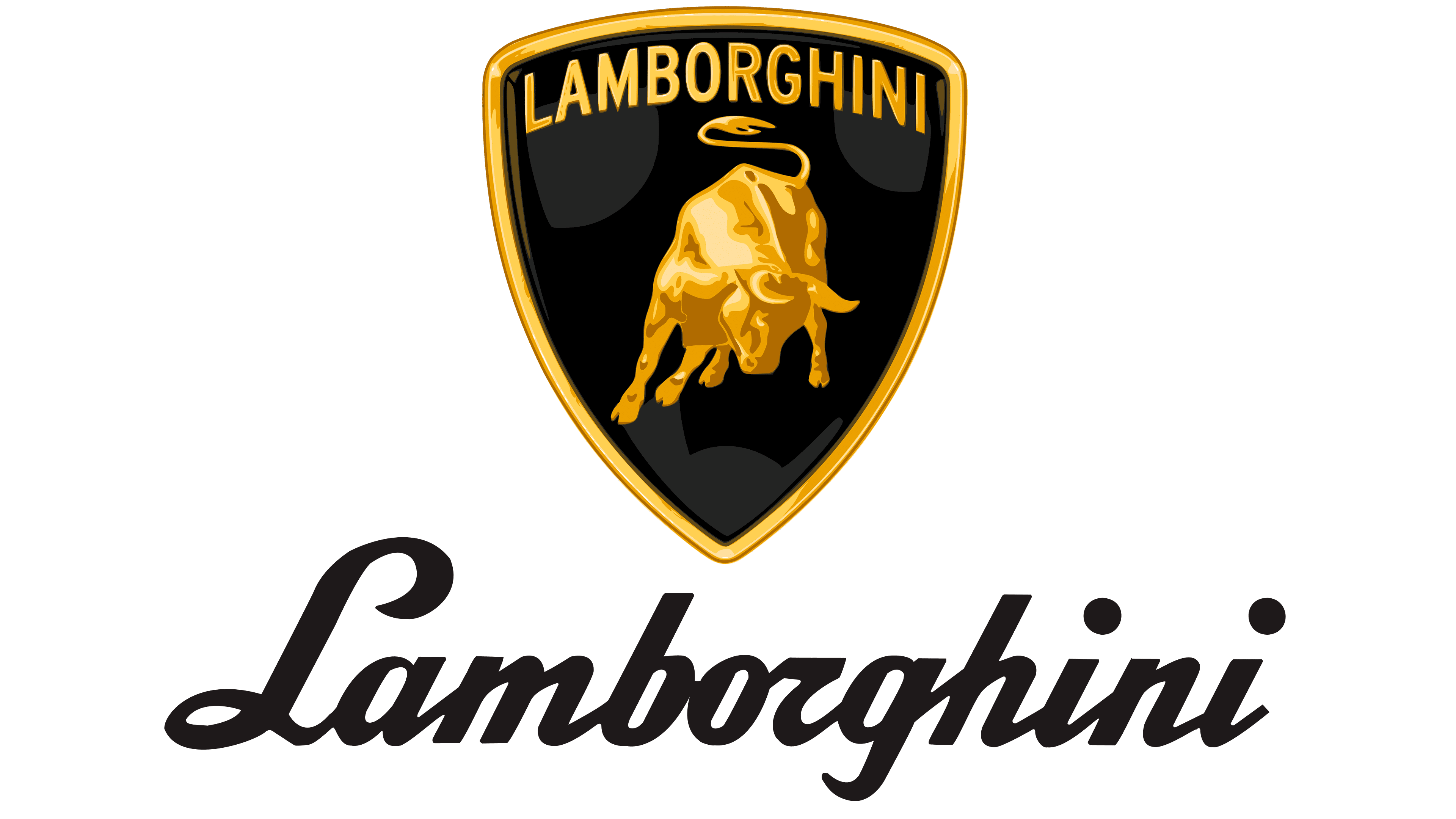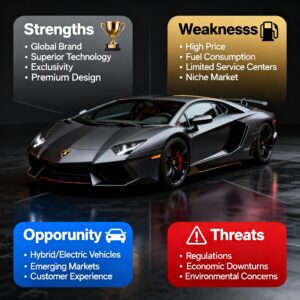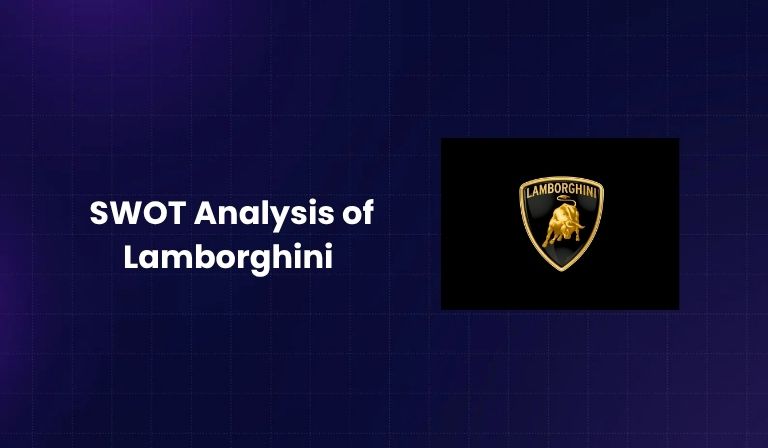Summary
Lamborghini is one of the most iconic luxury car brands in the world. Known for speed, design, and exclusivity, it has created a strong position in the global automotive market. This SWOT analysis of Lamborghini explores its strengths, weaknesses, opportunities, and threats in 2025. The analysis shows how Lamborghini maintains its brand power while facing challenges like environmental concerns, rising competition, and market volatility. It also highlights opportunities for innovation in electric and hybrid vehicles, expansion in global markets, and customer experience improvement.
Lamborghini is a luxury automobile company founded in 1963 by Ferruccio Lamborghini in Italy. It produces supercars, sports cars, and SUVs that are globally recognized for performance and exclusivity. The brand is now owned by the Volkswagen Group through its subsidiary Audi. Over the decades, Lamborghini has built a reputation as a status symbol for the wealthy, delivering powerful engines and futuristic designs.
In this blog, we will conduct a detailed Lamborghini SWOT analysis to understand its internal strengths and weaknesses, along with external opportunities and threats. This structured review will help explain how Lamborghini competes in the global automotive industry and what strategies can support its growth in the coming years.
About Lamborghini

- Industry: Automotive (Luxury Cars and SUVs)
- Founded: 1963 by Ferruccio Lamborghini
- Headquarters: Sant’Agata Bolognese, Italy
- Parent Company: Volkswagen Group (Audi subsidiary)
- Products: Luxury sports cars, SUVs, racing cars, marine engines, motorcycles
- Key Models: Aventador, Huracán, Urus SUV
- Sales Figures: Around 7,430 units sold in 2022, compared to 3,457 in 2016 (Statista)
Lamborghini is not a mass-market brand. It thrives on exclusivity by producing limited units each year, maintaining desirability, and strengthening its luxury image. The company also owns the Museo Lamborghini, which showcases its legacy of cars and engines.
Lamborghini SWOT Analysis

Strengths of Lamborghini
Global Brand Recognition
Lamborghini enjoys one of the strongest brand names in the luxury car industry. It is known worldwide for exclusivity, design, and speed. The Lamborghini logo and car design are instantly recognizable. This strong identity creates customer loyalty and positions it as a dream brand for enthusiasts.
Superior Technology and Engines
Lamborghini is known for its powerful V-12 and V-10 engines. These engines deliver extreme performance, often exceeding 200 mph in under 10 seconds. Customers associate Lamborghini with unmatched driving experience, advanced aerodynamics, and innovative engineering.
Exclusivity and Limited Production
Lamborghini maintains exclusivity by producing only around 3,000 to 7,000 units annually. Unlike mass-market competitors, this strategy keeps demand high and prevents brand dilution. Exclusivity ensures that owning a Lamborghini is a symbol of wealth and success.
Luxury Market Positioning
The company successfully targets the affluent class. Lamborghini cars are popular among celebrities, politicians, and business leaders. This positioning strengthens its image as a premium product.
Innovation in Hybrid and Electric Concepts
Lamborghini has been working on concept models for hybrid and electric vehicles. These innovations align with global demand for sustainable mobility. The move also helps the company prepare for stricter emission norms in Europe and the US.
Strong Backing from Volkswagen Group
Being part of Volkswagen provides Lamborghini with financial stability and access to technology sharing. Audi’s engineering expertise and VW’s global presence give Lamborghini an advantage in research and distribution.
Motorsports Heritage
Lamborghini has a strong presence in motorsports, which boosts its reputation as a performance-driven brand. Engines developed for racing also inspire innovations in its commercial cars.
Design and Style
Lamborghini cars are known for futuristic design and Italian craftsmanship. The styling makes them highly desirable, reinforcing their position as luxury symbols.
Also Read: SWOT Analysis of Jeep
Weaknesses of Lamborghini
High Price Point
Lamborghini cars are priced at a premium, making them affordable only to a limited group. During economic downturns, this premium pricing often reduces demand drastically.
High Fuel Consumption
The cars consume large amounts of fuel, which raises operating costs for owners. This issue also creates negative publicity around environmental impact.
Limited Market Availability
Lamborghini is not widely available in all markets. Customers in some regions need to import cars, which increases costs and reduces accessibility.
After-Sales Service Challenges
Repairing a Lamborghini is often difficult and expensive. Lack of service centers in many regions makes it harder for owners to maintain their cars, reducing customer satisfaction.
Over-Dependence on Niche Market
The brand relies heavily on the luxury segment. Unlike brands with broader portfolios, Lamborghini cannot offset risks during financial crises.
Low Production Volume
While exclusivity is a strength, producing fewer cars also limits overall revenue growth compared to rivals like Ferrari or Porsche.
Eco-Friendly Image Gap
Lamborghini lags behind companies like Tesla in terms of eco-friendly vehicles. Its reliance on fuel-heavy engines is a weakness in today’s environment-conscious market.
Opportunities for Lamborghini
Hybrid and Electric Vehicles
Launching hybrid and electric models is a major opportunity. With global customers moving toward sustainability, Lamborghini can secure long-term relevance by offering high-performance electric cars.
Expanding Global Presence
Emerging luxury markets in India, China, and the Middle East provide room for growth. By expanding dealership and service networks, Lamborghini can capture new affluent customers.
Improved After-Sales Service
Building more service centers and improving spare part availability can enhance customer satisfaction and loyalty.
Increase in Production Based on Demand
Lamborghini can carefully increase production to meet rising demand while maintaining exclusivity. This will help prevent customers from shifting to competitors.
Luxury SUV Growth
The success of the Lamborghini Urus SUV has opened new revenue opportunities. Expanding the SUV lineup can help Lamborghini attract a wider audience without losing brand prestige.
Collaborations and Limited Editions
Launching special editions and collaborations with fashion and technology brands can increase desirability and reinforce Lamborghini’s premium status.
Enhanced Customer Experience
Organizing luxury events, owner clubs, and exclusive driving experiences can strengthen the brand’s relationship with its customers.
Threats to Lamborghini
Environmental Concerns
Lamborghini cars consume high levels of fuel and emit more carbon, which makes them vulnerable to stricter global emission norms.
Regulatory Challenges
Governments worldwide are tightening emission and safety regulations. Non-compliance can lead to fines or bans in key markets.
Intense Competition
Lamborghini faces stiff competition from Ferrari, Porsche, Aston Martin, Jaguar, and even electric car makers like Tesla. Competitors are innovating faster in electric mobility.
Economic Downturns
Luxury cars are highly sensitive to financial crises. Economic slowdowns can sharply reduce demand for Lamborghini cars.
Fuel Price Volatility
High-performance cars rely on large fuel consumption. Rising fuel prices can discourage potential buyers.
Niche Luxury Car Makers
Smaller brands and regional car modifiers offer personalized luxury solutions, which can attract Lamborghini’s potential buyers.
Conclusion
The Lamborghini SWOT analysis highlights the company’s strong brand image, innovation, and exclusivity. These factors have helped it remain one of the most desirable luxury car brands in the world. However, weaknesses like high fuel consumption, premium pricing, and limited accessibility remain challenges.
The opportunities in hybrid cars, electric mobility, SUVs, and emerging markets provide Lamborghini with a chance to grow further. At the same time, threats from regulations, competition, and environmental concerns must be managed carefully.
In conclusion, Lamborghini’s strategy should focus on sustainable innovation, wider service networks, and expanding its product line. By adapting to customer needs and regulatory changes, the company can strengthen its position as a leader in the luxury car market.
FAQs
What is the biggest strength of Lamborghini?
The biggest strength of Lamborghini is its strong global brand recognition and powerful engine technology.
What are the weaknesses of Lamborghini?
High prices, high fuel consumption, limited service centers, and dependence on niche luxury markets are the main weaknesses.
What opportunities can Lamborghini explore in 2025?
The main opportunities include hybrid and electric vehicles, expansion into emerging markets, luxury SUVs, and improved after-sales service.
Who are Lamborghini’s competitors?
Ferrari, Porsche, Aston Martin, Jaguar, and Tesla are the main competitors.
What is the conclusion of Lamborghini SWOT analysis?
The conclusion of Lamborghini’s SWOT analysis is that it must balance exclusivity and performance with sustainability and accessibility to maintain long-term success.
A digital marketer with a strong focus on SEO, content creation, and AI tools. Creates helpful, easy-to-understand content that connects with readers and ranks well on search engines. Loves using smart tools to save time, improve content quality, and grow online reach.

